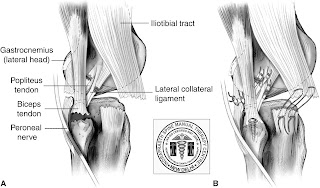POSTEROLATERAL CORNER (PCL) - Injuries to the posterolateral corner of the knee are most commonly associated with athletic traumas, motor vehicle accidents and falls. PLC injuries account for bit of all knee ligament injuries and often occur in combination with other cruciate ligament injuries. PLC provides both static and dynamic stabilisation to the knee joint. The static structures include the lateral collateral ligament (LCL or FCL), popliteus tendon, the popliteofibular ligament and the posterolateral capsule. Together these structures prevent varus collapse at the knee and external rotation of the tibia on the femur. Dynamic structures of the PLC play similar roles as the static structures but through movement. These structures include the popliteus muscle, iliotibial band, bicep femoris and the lateral gastroc tendon.
Injuries affecting the PLC may or may not occur in conjunction with injuries to other structures in the knee. Symptoms of a PLC injury commonly include:
- Pain and/or swelling over the posterolateral surface of the knee
- Pain which is aggravated by weight-bearing activities, especially those involving high loads going through the lower limb such as walking up a hill, quick direction changes or jumping
- Feeling of weakness or ‘giving way’ around the knee
If you have an injury to the PLC and the peroneal nerve is affected, you may also experience pins and needles and/or numbness in the lower leg and foot. You may also experience foot or ankle weakness.


No comments:
Post a Comment